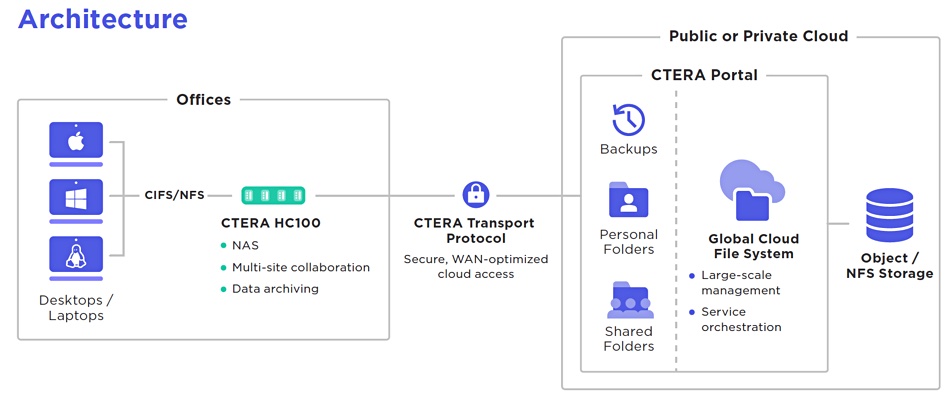CTERA has launched a small office/home office filer system for remote working employees.
The Remote Work Suite has two components, a portable disk drive-sized HC100 NAS filer with 1TB of usable NVMe-accessed flash, and a lightweight file access agent. The HC100 is a much downsized CTERA Edge Filer. These H-series systems come in a 16TB tower, or 2 and 6 rack unit chassis with 16TB or 32TB, 96TB and 128TB of usable capacity.

Oded Nagel, CTERA’s chief strategy officer, said: “With the new remote work suite, we are further extending the reach of the corporate file system to small branches and home office environments, while maintaining HQ-grade performance and security.”
The Edge Filers are intende for ROBO (remote office/branch office) applications. CTERA has extended its edge system coverage outwards with the HC100 boxlet, to smaller SOHO – small office/home office environments.
CTERA hasn’t disclosed the processor inside the HC100 but given the small physical size we imagine it’s an Arm or Intel Atom-type CPU. The little box provides SMB/CIFS and NFS access to files across a 1GbitE link. It operates in the same global namespace as the customer’s other CTERA file access boxes and links to the central cloud-based object repositories that underlie CTERA’s technology.
The lightweight file access agent runs on Windows or Mac notebooks and desktops and is called Drive Connect.

ReNAScence
CTERA’s general pitch is that data centre NAS (network-attached storage) is dead. The company argues that the technology is being replaced by file access to public cloud or hyperscale data centres, and caching edge filers linked to these central stores. And its response is to re-invent NAS hardware and software as file-access caching edge devices that send and receive data to/from a central and globally deduplicated cloud-located, object-based store.
The edge filers provide security and backup, and users in different locations can collaborate on a shared set of centrally-held files. The caching provides local access speed and the object store provides public cloud-type costs. CTERA claims this is much cheaper than on-premises filers from suppliers such as NetApp, Dell EMC Isilon and Qumulo.
CTERA’s systems are similar in scope to those from Nasuni, Panzura and Egnyte. However, none of these suppliers support SOHO users with similar HC100-style hardware.
Tens, hundreds or even thousands of the HC100s can be rolled out to corporate SOHO sites and centrally managed. Check out a CTERA document to find out more.
GigaOm senior data storage analyst Enrico Signoretti provided a supportive statement: “Enterprises must address urgent challenges related to providing access for small remote offices and work-from-home scenarios. CTERA’s ability to extend cloud file services to any office or endpoint while preserving organisational security and control fits a lot of distributed enterprises’ needs in the post-Covid era.”
These days the ‘S’ in SOHO could stand for serviced office, as newly non-commuting employees take to working in local serviced offices or their kitted-out garden sheds. It’s a post-pandemic remote working world out there, and CTERA wants a piece of it.








